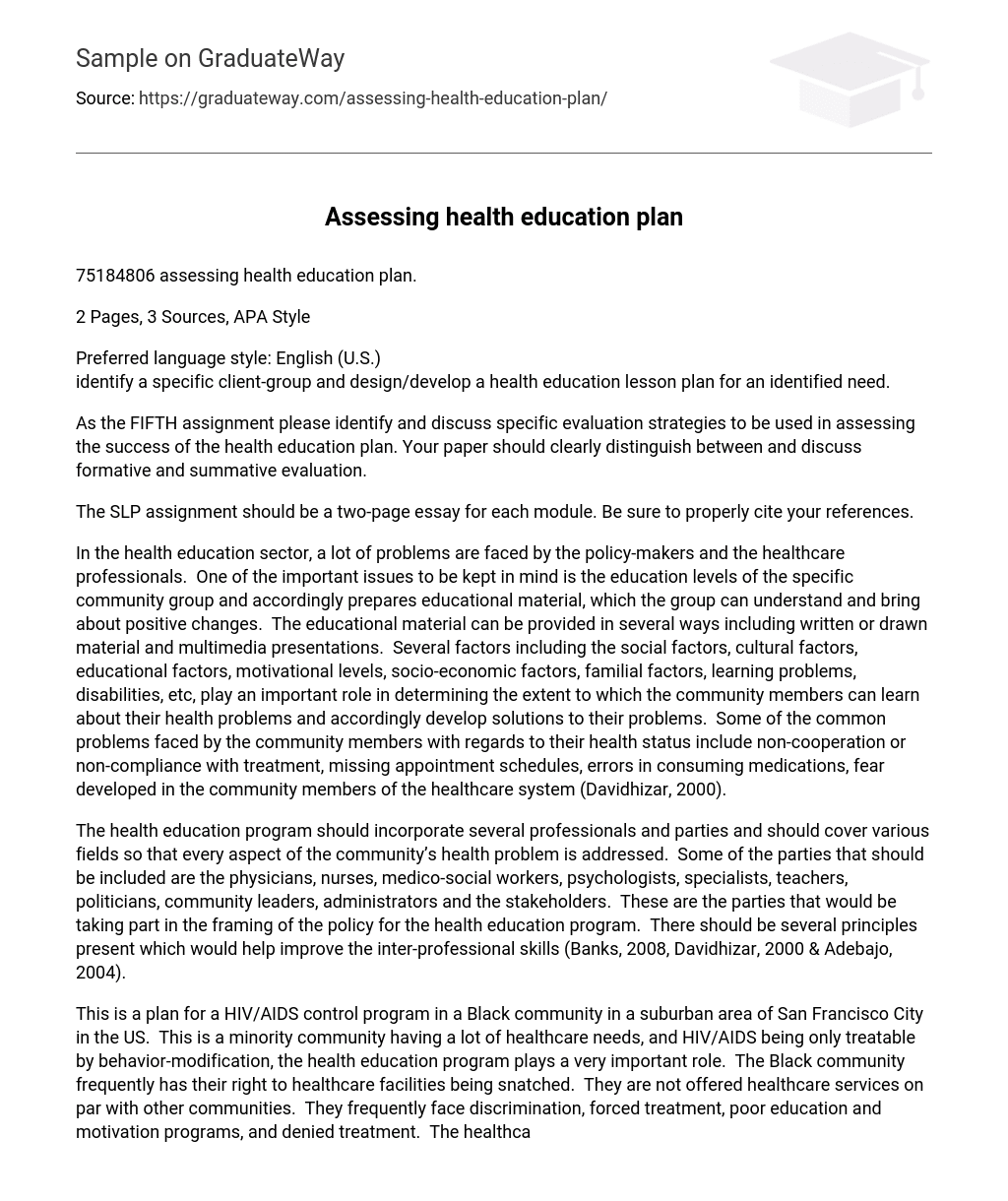75184806 assessing health education plan.
2 Pages, 3 Sources, APA Style
Preferred language style: English (U.S.)
identify a specific client-group and design/develop a health education lesson plan for an identified need.
As the FIFTH assignment please identify and discuss specific evaluation strategies to be used in assessing the success of the health education plan. Your paper should clearly distinguish between and discuss formative and summative evaluation.
The SLP assignment should be a two-page essay for each module. Be sure to properly cite your references.
In the health education sector, a lot of problems are faced by the policy-makers and the healthcare professionals. One of the important issues to be kept in mind is the education levels of the specific community group and accordingly prepares educational material, which the group can understand and bring about positive changes. The educational material can be provided in several ways including written or drawn material and multimedia presentations. Several factors including the social factors, cultural factors, educational factors, motivational levels, socio-economic factors, familial factors, learning problems, disabilities, etc, play an important role in determining the extent to which the community members can learn about their health problems and accordingly develop solutions to their problems. Some of the common problems faced by the community members with regards to their health status include non-cooperation or non-compliance with treatment, missing appointment schedules, errors in consuming medications, fear developed in the community members of the healthcare system (Davidhizar, 2000).
The health education program should incorporate several professionals and parties and should cover various fields so that every aspect of the community’s health problem is addressed. Some of the parties that should be included are the physicians, nurses, medico-social workers, psychologists, specialists, teachers, politicians, community leaders, administrators and the stakeholders. These are the parties that would be taking part in the framing of the policy for the health education program. There should be several principles present which would help improve the inter-professional skills (Banks, 2008, Davidhizar, 2000 & Adebajo, 2004).
This is a plan for a HIV/AIDS control program in a Black community in a suburban area of San Francisco City in the US. This is a minority community having a lot of healthcare needs, and HIV/AIDS being only treatable by behavior-modification, the health education program plays a very important role. The Black community frequently has their right to healthcare facilities being snatched. They are not offered healthcare services on par with other communities. They frequently face discrimination, forced treatment, poor education and motivation programs, and denied treatment. The healthcare professionals do not have the skills and the knowledge to handle the Black patients in the healthcare setup. The HIV/AIDS rates are very high in the population, including new cases every year, mortalities and development of AIDS-symptoms. Hence educational programs play a very important role, as they could help change behavior and decrease the rates of new cases and mortalities every year. One of the most important aspects would help the community members identify the routes through which the disease would spread (including unsafe sex, blood transfusion, IV drug usage, and maternal-child route). The educational products would be prepared by using various resources, including members of the community who are able to identify the issues faced by the community members and accordingly develop solutions for these problems. During the evaluation of the program, it is necessary to utilize both summative and formative evaluation methods to assess efficiency of the learning material. The Summative evaluation would help to get a quantitative score of the extent to which the learner have developed positive skills. However, advanced evaluation techniques need to be conducted to test-run various aspects of the educational material, so that the learners would be using a constantly updated learning product. Constant feedback needs to be taken on each and every sector of the educational product, to identify any inconsistency and rectify it immediately. The formative evaluation technique is more research-oriented than the summative evaluation technique which is more action-oriented. The human resources in the education program need to be trained constantly, and should be able to understand the attitudes, behavior, problems and needs of the community. Self-assessments and monitoring should be ongoing. A record needs to be made constantly of the progress made in learning and education of each and every community member. All the parties should have a collaborative role in the program. It is also important to know that during cross-cultural interactions, conflicts are very likely to occur as these members are very sensitive. Hence, efforts should be made to resolve the conflicts and better still to prevent them (USHHS, 2007, & Northern Arizona University, 2008).
References:
Adebajo, A., Blenkiron, L. and Dieppe, P. (2004). Patient education for diverse populations. Retrieved on August 3, 2007, from http://rheumatology.oupjournals.org/cgi/content/full/43/11/1321
Davidhizar, R. E. and Brownson, K. (1999). Literacy, cultural diversity, and client education. The Health Care Manager 18 (1), 39. Retrieved on August 3, 2007, from Proquest. http://hhc.sagepub.com/cgi/content/abstract/12/2/38?ck=nck
New Horizons for Learning (2002). Essential Principles for Teaching and Learning in a Multicultural Society. Retrieved on August 3, 2007, from http://www.newhorizons.org/strategies/multicultural/banks.htm
Northern Arizona University. Formative vs. Summative Evaluation. Retrieved on November 15, 2006, from
http://jan.ucc.nau.edu/edtech/etc667/proposal/evaluation/summative_vs._formative.htm
The Office of Minority Health. National Standards on Culturally and Linguistically Appropriate Services. Retrieved on November 15, 2006, from http://www.omhrc.gov/templates/browse.aspx?lvl=2&lvlID=15





